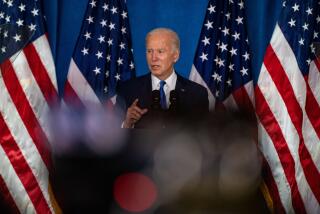Unequal Prosecution Means Unequal Justice : Crime: A $3,100 crack sale doesn’t merit the same sentence as a $37,000 cocaine sale. Yet that’s the effect of skewed federal priorities.
- Share via
Today the U.S. Supreme Court will hear arguments in a case alleging federal officials selected suspected crack cocaine dealers for prosecution on the basis of race. The Clinton Justice Department, somewhat surprisingly, has insisted that there should be no judicial inquiry into the acknowledged fact that the overwhelming majority of federal crack prosecutions are against black defendants. Regardless of how the court rules, the Justice Department’s day-to-day treatment of crack cases is an indefensible aberration.
Federal drug prosecutions are shaped by two pivotal factors. First, the government has the resources to prosecute only a small portion of all drug violations in the United States. In a typical year, out of more than a million drug arrests in the nation, only about 15,000 are prosecuted in federal court--less than 2%. Second, federal law imposes sentences that often are far harsher than those imposed by state law for the same offense. In the case being argued today, the principal defendant faces a minimum federal sentence of 55 years; the state minimum would be only 3 years.
In selecting the defendants to be subjected to exposure to these stiffer sentences, the federal practice ought to pursue the policy suggested last November by U.S. Attorney Nora Manella in Los Angeles: Focus on the most significant dealers and offenders, regardless of what drug they happen to be trafficking in. But the Justice Department treats crack cases, in which 88% of the federal defendants are black, in a completely different manner; it routinely seeks the harshest penalty against relatively minor crack offenders. In 1992, according to a report issued last year by the U.S. Sentencing Commission, 60% of all federal crack prosecutions were of street level sales.
Federal policy is precisely the opposite for individuals suspected of selling marijuana and methamphetamine, offenses where 68% of the offenders are white. Only 13% of these defendants are street-level dealers. Many of the street-level dealers selling methamphetamine and marijuana end up in federal court only because they were arrested as part of a larger drug organization, and are thus usually eligible for reduced sentences because of their minor roles within those operations. The great majority of street-level crack dealers are not arrested in connection with a larger federal operation and so are not eligible for a sentence reduction.
Those differences in federal charging practices are reflected in the resulting sentencing patterns. The median federal crack sentence, 97 months, corresponds to the median base sentence for a sale of $3,100 worth of crack, approximately 27 grams. The median federal sentence for those convicted of selling powder cocaine, 73% of whom are not black, corresponds to the median base sentence for selling 345 grams of powder cocaine, worth approximately $37,000. Similarly, the median sentences for methamphetamine, heroin and marijuana correspond to the median base sentences, respectively, for sales of $52,000, $90,000 and $415,000.
This peculiar charging pattern is misguided for many reasons unrelated to race. There are fixed and limited resources available for federal prosecutions. Every prosecution of a minor street-level crack dealer means that one less prosecution can be brought against a higher-level dealer in powder cocaine, heroin, methamphetamine or marijuana.
This charging disparity creates equally peculiar incentives in the law enforcement system. An informant, anxious to please his handlers with a case that will be deemed worthy of federal prosecution, will understand that setting up a 50-gram crack sale is far easier, and likely safer, than a 1,000-gram powder cocaine sale.
Many of the policy problems posed by the scourge of drug trafficking are painfully intractable; this one is not. The attorney general could eliminate these indefensible disparities by issuing a simple directive that a street value guideline be used to determine which dealers should be subjected to federal prosecution and the imposition of the typically harsher federal sentences. That would not guarantee victory in the war on drugs, but it would at least assure that the war is fought evenhandedly on all fronts.
More to Read
Sign up for Essential California
The most important California stories and recommendations in your inbox every morning.
You may occasionally receive promotional content from the Los Angeles Times.













